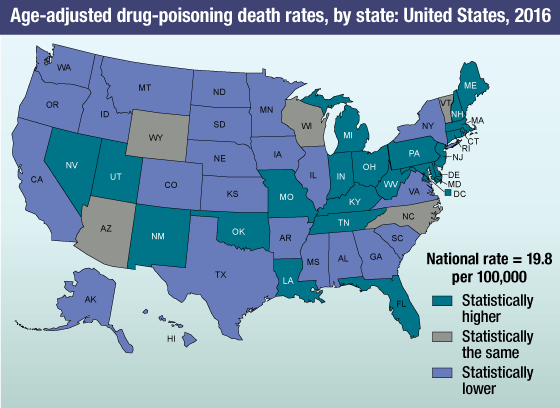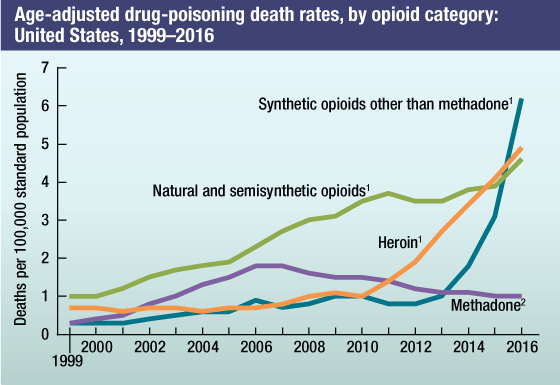NCHS Data on Drug-poisoning Deaths
NCHS Fact Sheet, October 2018
PDF Version pdf icon[PDF – 287 KB]
About NCHS
The National Center for Health Statistics (NCHS) is the nation’s principal health statistics agency, providing data to identify and address health issues. NCHS compiles statistical information to help guide public health and health policy decisions.
Collaborating with other public and private health partners, NCHS uses a variety of data collection mechanisms to obtain accurate information from multiple sources. This process provides a broad perspective on the population’s health, influences on health, and health outcomes.
NCHS drug-poisoning data
Poisoning is the leading cause of injury death in the United States. Drugs—both pharmaceutical and illicit—cause the vast majority of poisoning deaths.
NCHS uses the National Vital Statistics System (NVSS) to monitor deaths due to drug poisoning (overdose). NVSS collects mortality information from death certificates in all 50 states and the District of Columbia. NCHS identifies the number of drug-poisoning deaths from the underlying cause of death on death certificates. Multiple causes of death are used to identify deaths involving specific drugs. In 2016, approximately 15% of death certificates for drug-poisoning deaths lacked information on the specific drugs involved.
Recent findings
- From 1999 to 2016, drug-poisoning death rates more than tripled, from 6.1 per 100,000 to 19.8 per 100,000. In 2016, there were 63,632 deaths due to drug poisoning. Provisional estimates for 2017 suggest an increase to 72,287 drug-poisoning deaths.
- In 2016, the age-adjusted rate for drug-poisoning deaths for males (26.2 per 100,000) was almost double that of females (13.4).
- From 1999 to 2016, the age-adjusted rate of drug-poisoning deaths increased from 8.2 per 100,000 to 26.2 per 100,000 for males, and from 3.9 per 100,000 to 13.4 per 100,000 for females.
Who is most at risk?
- From 1999–2016, the drug-poisoning death rates increased for all age groups.
- In 2016, the drug-poisoning death rates were highest for persons aged 35–44 (35.0 per 100,000), 25–34 (34.6), and 45–54 (34.5).
- In 2016, the age-adjusted death rate was 25.3 for non-Hispanic white persons, 17.1 for non-Hispanic black persons, and 9.5 for Hispanic persons.
 image icon
image icon
1Significant increasing trend from 1999 to 2016 with different rates of change over time, p < 0.001.
22016 rate for male was significantly higher than for female, p < 0.001.
SOURCE: NCHS, National Vital Statistics System Mortality File.
Drug-poisoning death rates, by state and the District of Columbia
Deaths per 100,000 population varied by state. In 2016, the four states, and the District of Columbia, with the highest age-adjusted drug-poisoning death rates were:
- West Virginia (52.0)
- Ohio (39.1)
- New Hampshire (39.0)
- District of Columbia (38.8)
- Pennsylvania (37.9)
 image icon
image icon
NOTE: Drug-poisoning death rates are age-adjusted deaths per 100,000 standard population.
SOURCE: NCHS, National Vital Statistics System, 2016.
Drug-poisoning death rates by opioid category
- The rate of drug-poisoning deaths involving natural and semisynthetic opioids, which include drugs such as oxycodone and hydrocodone, increased from 1.0 in 1999 to 4.4 in 2016.
- The rate of drug-poisoning deaths involving methadone increased from 0.3 in 1999 to 1.8 in 2006, then declined to 1.0 in 2016.
- The rate of drug-poisoning deaths involving heroin increased from 0.7 in 1999, to 1.0 in 2010, to 4.9 in 2016.
- The rate of drug-poisoning deaths involving synthetic opioids other than methadone, which includes drugs such as fentanyl, fentanyl analogs, and tramadol, doubled from 2015 to 2016. The rate increased from 0.3 per 100,000 in 1999 to 1.0 in 2013, 1.8 in 2014, 3.1 in 2015, and 6.2 in 2016.
 image icon
image icon
1Significant increasing trend from 1999 to 2016 with different rates of change over time, p < 0.05.
2Significant increasing trend from 1999 to 2006, then decreasing trend from 2006 to 2016, p < 0.05.
SOURCE: NCHS, National Vital Statistics System, Mortality.
Challenges and future opportunities
- Improve reporting of the specific drug(s) involved in drug-poisoning deaths on the death certificate.
- Enhance capacities to search the cause-of-death description on the death certificate for drug mentions.
- Work with medical examiners and coroners to improve timeliness of reporting drug-poisoning deaths.
- Improve automated cause-of-death coding systems for faster reporting.
- Explore opportunities to link electronic death records to electronic health records.
- Develop capacity to support monthly reporting of drug-poisoning deaths.
For more information about NCHS, visit https://www.cdc.gov/nchs.
For more information about NVSS, visit https://www.cdc.gov/nchs/nvss.htm.